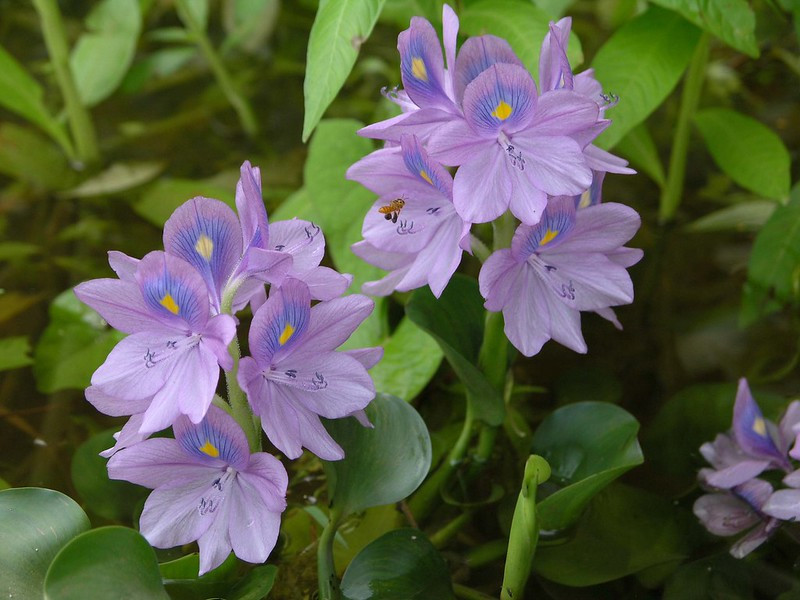
Common Water Hyacinth Facts
- This gorgeous product of Nature and evolution most frequently goes by the english language name of the Common Water Hyacinth. It does have at least a few alternate titles, though. These include the appellations water orchid and floating water hyacinth.
- Among those in scientific fields, however, it’s perhaps better known by its technical label. Like many such, though, that’s a somewhat difficult epithet for the layperson to pronounce. That’s because the plant holds the official designation Pontederia crassipes.
- The botanical beauty received that formal moniker due to the efforts of Carl Friedrich Philipp von Martius. The respected German botanist accomplished the first offical recognition of it as a separate and distinct species. He managed that feat in 1824.
- No matter which of these honorifics one chooses to use, it remains a flora of some note. Due to its beauty, it’s been naturalized throughout the world. In many regions, though, it’s become invasive. The plant’s also the only member of its specific subgenus.
- Thankfully, the stunning Common Water Hyacinth continues to maintain a population base that’s both stable and sufficient in its native range. That further seems to hold true across that territory. The IUCN therefore has no listing for it on its Red List.
- The marvel of Nature nonetheless should be considered as facing several potential threats to its existence, at least. Like other species, many of these stem from the actions of mankind. They include the related perils of habitat loss and climate change.
Related Articles
Common Water Hyacinth Physical Description
Deceptively named, the stunning Common Water Hyacinth is anything but common in its visual appeal. Yet, as impressive as that is, it’s hardly the only reason one has for admiring this work of Nature. That’s true since the flora also attains respectable measurements.
Amazingly, the Angiosperm actually evolved as a perennial aquatic plant. The intriguing species appears capable of reaching vertical heights of as much as 3.3 ft (1 m). Most examples, however, remain slightly smaller than this. This varies due to local conditions.
The roots of the wonder float freely beneath the surface, growing to varying lengths. Every specimen produces a large number of these, to provide its needs. Each of these presents a striking purplish-black shade. This structure also tends to have a feathery appearance.
Above the water, though, each of these incredibly beautiful Tracheophytes possesses numerous lengthy, spongy, somewhat bulbous stalks. Despite their texture, these grow in a moderately erect manner. It’s from these structures that the visual splendor appears.
And it’s these for which the Common Water Hyacinth remains best known, and most appreciated. Between 8 – 15 of these blooms form on each stalk. Colors very, but lavendar to pink is the most frequent. All blossoms produce a total of six delicate, lacy petals.
Meanwhile, the foliage of this marvel create a fabulous counterpoint to the brilliant flowers. These leaves range in length from 4 – 8 in (10 – 20cm), with many on each stem. These float on bulb-like nodules. Each also has a thick texture, with a smooth, glossy green color.
- Kingdom: Plantae
- Phylum: Tracheophytes
- Class: Monocots
- Order: Commelinales
- Family: Pontederiaceae
- Genus: Pontederia
- Species: P. crassipes
Common Water Hyacinth Distribution, Habitat, and Ecology
The mesmerizing Common Water Hyacinth actually developed as endemic to a moderately small region of the earth’s surface. The precise setting for this development probably won’t surprise many people, though. That’s true since it’s native to part of South America.
Within that greater zone of habitation, however, evidence indicates that it evolved as present in only one small portion of the continent. That’s inside the borders of what’s now the country of Brazil. Evidence further indicates it never spread beyond that range on its own.
Fortunately for it, this natural sensation evolved as quite flexible in its choice of habitat. It’s therefore found in a fairly wide range of differing ecosystems. The majority of these, though, still fall within the climatic range falling between tropical and subtropical.
Displaying its versatility, it seems to thrive well in such diverse regions as tropical deserts and temperate one’s. Yet, it also loves regions of warm, moist, rainforest. The remarkable plant does not appear to mind varying altitudes either, flourishing up to moderate heights.
As mentioned previously, the fascinating Common Water Hyacinth developed as a type of aquatic plant. But not just any water source suffices. It shows a decidedly strong preference for slow-moving waters. This typically includes ponds, lakes, and gently-flowing streams.
Although various insects do visit its blooms, these don’t form it’s principal form of pollination. Instead, it achieves the majority of this process via the actions of the wind itself. It’s also an extremely fast-growing species, capable of doubling its size within a short period.
Species Sharing Its Range
Brazilian Wandering Spider
Checkout our other articles on 5 Beautiful Black Sea Species, Fire Salamander, Victoria Falls, Eurasian Brown Bear, Australian Painted Lady, West Indian Ocean Coelacanth, Jewelled Gecko
